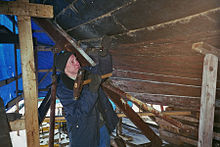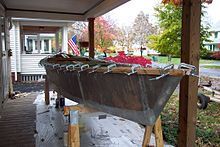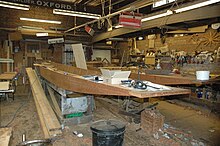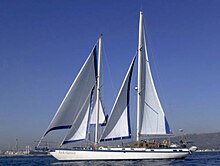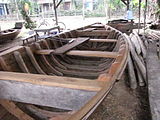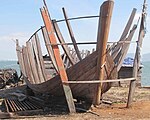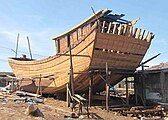
A boat is a watercraft of a large range of types and sizes, but generally smaller than a ship, which is distinguished by its larger size, shape, cargo or passenger capacity, or its ability to carry boats.

A hull is the watertight body of a ship, boat, submarine, or flying boat. The hull may open at the top, or it may be fully or partially covered with a deck. Atop the deck may be a deckhouse and other superstructures, such as a funnel, derrick, or mast. The line where the hull meets the water surface is called the waterline.
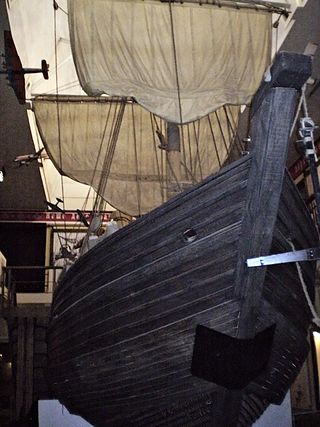
The koch was a special type of small one- or two-mast wooden sailing ships designed and used in Russia for transpolar voyages in ice conditions of the Arctic seas, popular among the Pomors.

Carvel built or carvel planking is a method of boat building in which hull planks are laid edge to edge and fastened to a robust frame, thereby forming a smooth surface. Traditionally the planks are neither attached to, nor slotted into, each other, having only a caulking sealant between the planks to keep water out. Modern carvel builders may attach the planks to each other with glues and fixings. It is a "frame first" method of hull construction, where the shape is determined by the framework onto which the planks are fixed. This is in contrast to "plank first" or "shell first" methods, where the outer skin of the hull is made and then reinforced by the insertion of timbers that are fitted to that shape. The most common modern "plank first" method is clinker construction; in the classical period "plank first" involved joining the edges of planks with mortise and tenon joints within the thickness of the timbers, superficially giving the smooth-hull appearance of carvel construction, but achieved by entirely different means.
Strip-built, or "strip-plank epoxy", is a method of boat building. Also known as cold molding, the strip-built method is commonly used for canoes and kayaks, but also suitable for larger boats. The process involves securing narrow, flexible strips of wood edge-to-edge around temporary formers. The temporary formers are usually created via a process called "lofting" whereby a set of tables is used to generate the shapes of the formers. The strips are glued edge-to-edge with epoxy. It is effectively a modern form of carvel which needs no caulking and which is both stiffer and more watertight. In a small boat, there will be just one layer of strip-planking, but larger vessels may have two or three layers which,, forms a light, strong, and torsionally stiff monococque.
This glossary of nautical terms is an alphabetical listing of terms and expressions connected with ships, shipping, seamanship and navigation on water. Some remain current, while many date from the 17th to 19th centuries. The word nautical derives from the Latin nauticus, from Greek nautikos, from nautēs: "sailor", from naus: "ship".

Clinker-built is a method of boat building in which the edges of hull planks overlap each other. Where necessary in larger craft, shorter planks can be joined end to end, creating a longer strake or hull plank.

On a vessel's hull, a strake is a longitudinal course of planking or plating which runs from the boat's stempost to the sternpost or transom. The garboard strakes are the two immediately adjacent to the keel on each side.

Philip C. Bolger was a prolific American boat designer, who was born and lived in Gloucester, Massachusetts. He began work full-time as a draftsman for boat designers Lindsay Lord and then John Hacker in the early 1950s.
A chine in boat design is a sharp change in angle in the cross section of a hull. The chine typically arises from the use of sheet materials as the mode of construction.
The Bell Woodworking Seagull and Seamew are both small sloop-rigged marine ply sailing boats of the Trailer yacht type designed by Ian Proctor, who was also responsible for the design of many small sailing dinghies in seven different classes including the extremely popular Topper, and Wanderer.

A sailing yacht, is a leisure craft that uses sails as its primary means of propulsion. A yacht may be a sail or power vessel used for pleasure, cruising, or racing. There is no standard definition, so the term applies here to sailing vessels that have a cabin with amenities that accommodate overnight use. To be termed a "yacht", as opposed to a "boat", such a vessel is likely to be at least 33 feet (10 m) in length and have been judged to have good aesthetic qualities. Sailboats that do not accommodate overnight use or are smaller than 30 feet (9.1 m) are not universally called yachts. Sailing yachts in excess of 130 feet (40 m) are generally considered to be superyachts.
Shell plating is the outer-most structure on the hull of a steel or aluminum ship or boat.
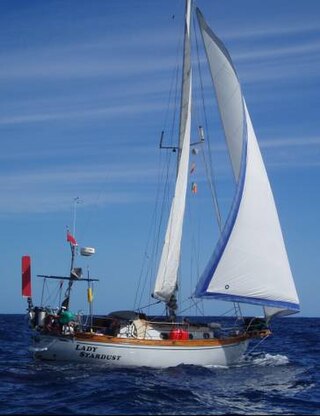
The Baba 30 was the smallest craft in the range but very popular, with some 170 having been built. They were built as sturdy vessels suitable for making long offshore and ocean passages needing only a couple of people to crew the boat. Although capable of sleeping 5 people they are generally sailed by couples. Most of these boats can be found in NW America but are also spread all around the world's ports and anchorages.
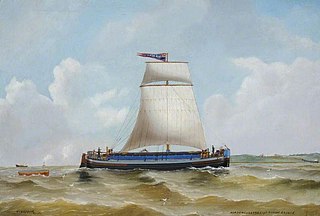
The Humber keel was a type of single-masted, square-rigged sailing craft used for inshore and inland cargo transport around Hull and the Humber Estuary, in the United Kingdom, particularly through the late 19th and early 20th centuries.

Norda is a wooden sailing vessel that was commissioned in 1928, originally used as a research vessel in Poland. It served as research vessel, fishing vessel and is now a yacht.

The Bluejacket 23 is a 23-foot (7.0 m) Canadian trailerable, fibreglass monohull sailboat designed by Cuthbertson & Cassian as a day sailer and club racer and first built in 1967.
The Dark Harbor 17 1/2 is a 25 ft 10 in long class of sailboat designed by B.B.Crowninshield in 1908 as a daysailer and racer.
The Watkins 25, also known as the W25 and marketed as the Seawolf 25 from 1986, is an American trailerable sailboat that was designed by the Watkins Design Team and first built in 1983.

Lashed-lug boats are ancient boat-building techniques of the Austronesian peoples. It is characterized by the use of raised lugs on the inner face of hull planks. These lugs have holes drilled in them so that other hull components such as ribs, thwarts or other structural components can be tied to them with natural fiber ropes. This allows a structure to be put together without any metal fastenings. The planks are further stitched together edge-to-edge by sewing or using dowels ("treenails") unto a dugout keel and the solid carved wood pieces that form the caps for the prow and stern. Characteristically, the shell of the boat is created first, prior to being lashed unto ribs. The seams between planks are also sealed with absorbent tapa bark and fiber that expands when wet or caulked with resin-based preparations.



